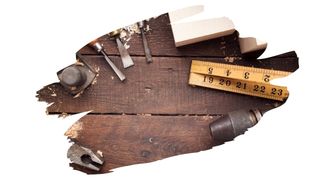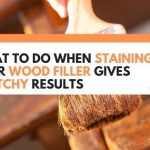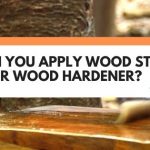If you’re like most cooks, your cutting board is probably used frequently throughout the day.
And over time, that chopping block can begin to look a little worse for wear. This is because sharp kitchen utensils can wear down a wooden surface, scratching and denting it.
Now, usually a wooden surface with knots, holes, or voids can be easily fixed with wood filler. But, how safe is it to use these plastic wood fillers on food prepping cutting boards?
Well, in this post, you will learn why a food safe wood filler doesn’t always mean that it’s safe enough to eat your dinner off of (or to prep your dinner on).
We also reveal which type of food safe wood filler product contains non-toxic natural resins (and zero micro-plastics).

This post may contain affiliate links to products that we receive a commission for (at no additional cost to you). Learn more here.
What Can You Do About Voids And Holes In A Cutting Board Or Butcher Block?
Voids and holes are an inevitable consequence of frequently prepping food on your cutting board.
However, they can’t be ignored. If you don’t do something about them, those holes can get bits of food caught in them. And that, in turn, will allow bacteria to grow and thrive inside your cutting board.
So, to avoid all of that, the easiest thing to do about those cutting board voids, is to simply fill them in.
Now, when it comes to woodworking in general, we typically use wood filler (or wood putty) to pack out holes. But, these grain filler products are usually made from micro-plastics or non-food grade resins.
But, an actively used cutting board needs to have a prepping surface that is wholly food grade. So, any part of a cutting board that has ‘direct’ contact with food must be made from food grade material.
In short, a food grade food prep surface should be made from materials that are wholly safe for human consumption.
Food Safe Does Not Equal Food Grade
Food safe wood glues, (if you check the packaging), will clearly state that they’re safe for ‘indirect’ contact with food.
What this means is that once these glues have wholly cured, they no longer ooze resins or release fumes.
But, that does not mean food safe finishes are wholly safe enough for you to eat your dinner off of. Only a food grade finish can lay claim to that promise.
Still, a durable long-lasting waterproof wood filler product — by its very nature — is going to contain man-made chemicals. And those chemicals will not be fit for human consumption.
So, instead, your best bet is to find a food safe wood filler that’s made (as much as possible) from natural ingredients.
OK. So What Is The Best Food Safe Filler For A Butcher Block Or Cutting Board?
It’s worth mentioning here that technically, food safe wood fillers should only be used on indirect-food-contact sections of your board.
If there’s any wood filler on the direct prepping side of your board, you risk chipping that wood filler with your kitchen utensils. And that, in turn, risks getting that material into your food.
That said, if you want to fill out holes on indirect-contact sections of your board, then use a shellac-based filler product.
Related Post: Is Shellac Food Safe Enough For A Cutting Board?
What Is Shellac?
Shellac is a natural resin sourced from lac bugs in Thailand and India. It is a highly waxy substance that’s used in a wide range of ways. For example, beyond wood finishing, shellac is used as a food additive to give some confectioneries a glossy shell.
Typically sold in the form of flakes, shellac needs to be thinned out with high proof alcohol to get it to melt down. But, once it does, it can be used as a fairly water-resistant wood sealer.
Now, shellac in its over the counter standard flake form isn’t enough to fix those cutting board holes. When it comes to filling in voids, you should use burn-in shellac sticks (also known as lacquer sticks).
Related Post: Thinning Shellac With Mineral Spirits Won’t Work (Here’s What Will)
What Is A Burn-in Shellac Stick (And How Does It Fill Voids On A Cutting Board)?
A burn-in shellac stick, (sometimes referred to as filler sticks or lacquer sticks), are used to fix knots in wood.
Burn-in sticks are usually made from resinous materials. But, burn in shellac sticks are specifically made from non-toxic shellac. Before modern day plastic wood fillers, burn-in shellac sticks were a traditional way to fill in deep knots.
The way these work is that you use a soldering iron to melt down a little bit of the stick. And then you pack the melted shellac into the void.
Afterwards, you can then carefully scrape away any left over shellac. Once the shellac has cooled and solidified, you then smooth it out by sanding it.
For a visual guide to using a burn-in stick, check out Touch Up Solutions quick demo below:
And What’s The Best Burn-In Shellac Stick For A Cutting Board?
The best one on the market is Liberons Shellac Filler Sticks. Their shellac sticks are derived from natural shellac, and they’re designed for repairing holes and voids.
But, more importantly, they sell their burn-in shellac sticks in packs of 3 different blendable colors. So, you can mix the different color sticks until the tone matches your cutting board.
You can find the latest prices for this burn-in filler stick over on Amazon.
To Wrap Up, Here Are The 3 Key Takeaways From This Post…
- 1). Voids in cutting boards run the risk of becoming filled with food bits and bacteria.
- 2). You can fill in voids using a food safe burn-in shellac stick.
- 3). Burn-in shellac filler sticks contain natural non-toxic shellac resins. And that makes this product one of the most food safe wood filler choices for a cutting board.



